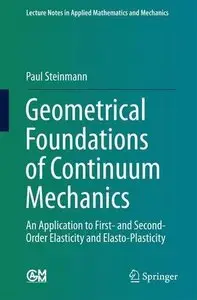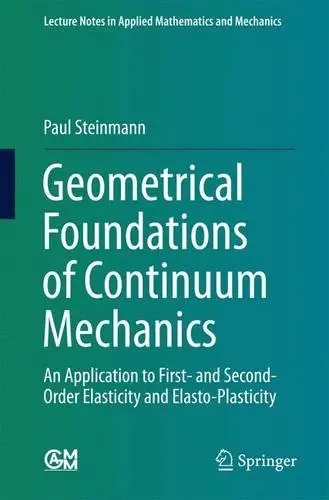Geometrical Foundations of Continuum Mechanics: An Application to First- and Second-Order Elasticity and Elasto-Plasticity
Springer | Applied Mathematics, Differential Geometry, Topology | May 14 2015 | ISBN-10: 3662464594 | 517 pages | pdf | 5.2 mb
Springer | Applied Mathematics, Differential Geometry, Topology | May 14 2015 | ISBN-10: 3662464594 | 517 pages | pdf | 5.2 mb
by Paul Steinmann (Author)
From the Back Cover
This book illustrates the deep roots of the geometrically nonlinear kinematics of
generalized continuum mechanics in differential geometry. Besides applications to first-
order elasticity and elasto-plasticity an appreciation thereof is particularly illuminating
for generalized models of continuum mechanics such as second-order (gradient-type)
elasticity and elasto-plasticity.
After a motivation that arises from considering geometrically linear first- and second-
order crystal plasticity in Part I several concepts from differential geometry, relevant
for what follows, such as connection, parallel transport, torsion, curvature, and metric
for holonomic and anholonomic coordinate transformations are reiterated in Part II.
Then, in Part III, the kinematics of geometrically nonlinear continuum mechanics
are considered. There various concepts of differential geometry, in particular aspects
related to compatibility, are generically applied to the kinematics of first- and second-
order geometrically nonlinear continuum mechanics. Together with the discussion on
the integrability conditions for the distortions and double-distortions, the concepts
of dislocation, disclination and point-defect density tensors are introduced. For
concreteness, after touching on nonlinear first- and second-order elasticity, a detailed
discussion of the kinematics of (multiplicative) first- and second-order elasto-plasticity
is given. The discussion naturally culminates in a comprehensive set of different types
of dislocation, disclination and point-defect density tensors. It is argued, that these
can potentially be used to model densities of geometrically necessary defects and the
accompanying hardening in crystalline materials. Eventually Part IV summarizes the
above findings on integrability whereby distinction is made between the straightforward
conditions for the distortion and the double-distortion being integrable and the more
involved conditions for the strain (metric) and the double-strain (connection) being
integrable.
The book addresses readers with an interest in continuum modelling of solids from
engineering and the sciences alike, whereby a sound knowledge of tensor calculus and
continuum mechanics is required as a prerequisite.
Your Premium Library in App... Effort, Please support :)
This book illustrates the deep roots of the geometrically nonlinear kinematics of
generalized continuum mechanics in differential geometry. Besides applications to first-
order elasticity and elasto-plasticity an appreciation thereof is particularly illuminating
for generalized models of continuum mechanics such as second-order (gradient-type)
elasticity and elasto-plasticity.
After a motivation that arises from considering geometrically linear first- and second-
order crystal plasticity in Part I several concepts from differential geometry, relevant
for what follows, such as connection, parallel transport, torsion, curvature, and metric
for holonomic and anholonomic coordinate transformations are reiterated in Part II.
Then, in Part III, the kinematics of geometrically nonlinear continuum mechanics
are considered. There various concepts of differential geometry, in particular aspects
related to compatibility, are generically applied to the kinematics of first- and second-
order geometrically nonlinear continuum mechanics. Together with the discussion on
the integrability conditions for the distortions and double-distortions, the concepts
of dislocation, disclination and point-defect density tensors are introduced. For
concreteness, after touching on nonlinear first- and second-order elasticity, a detailed
discussion of the kinematics of (multiplicative) first- and second-order elasto-plasticity
is given. The discussion naturally culminates in a comprehensive set of different types
of dislocation, disclination and point-defect density tensors. It is argued, that these
can potentially be used to model densities of geometrically necessary defects and the
accompanying hardening in crystalline materials. Eventually Part IV summarizes the
above findings on integrability whereby distinction is made between the straightforward
conditions for the distortion and the double-distortion being integrable and the more
involved conditions for the strain (metric) and the double-strain (connection) being
integrable.
The book addresses readers with an interest in continuum modelling of solids from
engineering and the sciences alike, whereby a sound knowledge of tensor calculus and
continuum mechanics is required as a prerequisite.
Your Premium Library in App... Effort, Please support :)



